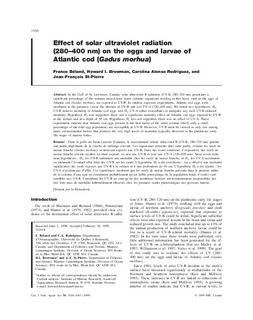| dc.description.abstract | In the Gulf of St. Lawrence, Canada, solar ultraviolet B radiation (UV-B, 280–320 nm) penetrates a
significant percentage of the summer mixed-layer water column: organisms residing in this layer, such as the eggs of
Atlantic cod (Gadus morhua), are exposed to UV-B. In outdoor exposure experiments, Atlantic cod eggs were
incubated in the presence versus the absence of UV-B and (or) UV-A (320–400 nm). We tested two hypotheses: H1,
UV-B induces mortality in Atlantic cod eggs, and H2, UV-A either exacerbates or mitigates any such UV-B-induced
mortality. Hypothesis H1 was supported: there was a significant mortality effect on Atlantic cod eggs exposed to UV-B
at the surface and at a depth of 50 cm. Hypothesis H2 was not supported: there was no effect of UV-A. These
experiments indicate that Atlantic cod eggs present in the first metre of the water column (likely only a small
percentage of the total egg population) are susceptible to UV-B. However, UV-B must be viewed as only one among
many environmental factors that produce the very high levels of mortality typically observed in the planktonic early
life stages of marine fishes. | en |
